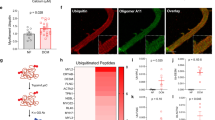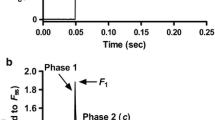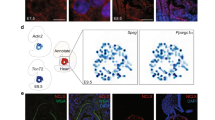Abstract
To study the genomic physiology of cardiac myofibril proteins in the heart, we have successfully created a cardiac troponin I (cTnI; a myofibril protein) gene knockout mouse model using gene targeting techniques. The phenotype of the cTnI gene knockout mouse is a cardiomyopathy with diastolic dysfunction resulting in sudden death in neonates. In the present studies, energy metabolism was analyzed in myocardial cells from cTnI-null hearts. Myofibril MgATPase activities were determined in myocardial cells from either wild-type or cTnI mutant mouse hearts. Furthermore, the quantity and quality of the mitochondria in wild-type and cTnI mutant animals were counted and analyzed. Our results demonstrate that damaged relaxation and increased Ca2+-independent force production in cTnI-null hearts is in part related to the increased myofibril MgATPase activities accompanied by an increase in mitochondria quantity and mitochondrial ATPase activities. These data indicate that cardiomyopathies with diastolic dysfunction are different from cardiomyopathies caused by systolic dysfunction. The former involves the damage of cardiac relaxation due to increased MgATPase activities and increased Ca2+-independent force production inside of myofilaments, while the latter involves the damage of systolic contraction due to decreased MgATPase activities and decreased force production.
Similar content being viewed by others
References
Alpert NR, Mulieri LA, Warshaw D. The failing human heart. Cardiovasc Res 54:1–10;2002.
Bonne G, Carrier L, Richard P, Hainque B, Schwartz K. Familial hypertrophic cardiomyopathy: From mutations to functional defects. Circ Res 83:580–593;1998.
Burton D, Abdulrazzak H, Knott A, Elliott K, Redwood C, Watkins H, Marston S, Ashley C. Two mutations in troponin I that cause hypertrophic cardiomyopathy have contrasting effects on cardiac muscle contractility. Biochem J 362:443–451;2002.
Chan KM, Delfert D, Junger KD. A direct colorimetric assay for Ca2+-stimulated ATPase activity. Anal Biochem 157:375–380;1986.
Deng Y, Schmidtmann A, Redlich A, Westerdorf B, Jaquet K, Thieleczek R. Effects of phosphorylation and mutation R145G on human cardiac troponin I function. Biochemistry 40:14593–14602;2001.
El-Saleh SC, Warber KD, Potter JD. The role of tropomyosin-troponin in the regulation of skeletal muscle contraction. J Muscle Res Cell Motil 7:387–404;1986.
Fabiato A, Fabiato F. Calculator programs for computing the composition of solutions containing multiple metals and ligands used for experiments in skinned muscle cells. J Physiol (Paris) 75:436–505;1979.
Ferasin L, Sturgess CP, Cannon MJ, Caney SM, Gruffydd-Jones TJ, Wotton PR. Feline idiopathic cardiomyopathy: A retrospective study of 106 cats (1994–2001). J Feline Med Surg 5:151–159;2003.
Foster DB, Noguchi T, VanBuren P, Murphy AM, Van Eyk JE. C-terminal truncation of cardiac troponin I causes divergent effects on ATPase and force: Implications for the pathophysiology of myocardial stunning. Circ Res 93:917–924;2003.
Gao WD, Liu Y, Perez NG, Murphy AM, Marban E. Role of troponin I proteolysis in the pathogenesis of stunned myocardium. Circ Res 80:393–399;1997.
Huang XP, Pi Y, Lee KJ, Henkel AS, Gregg RG, Powers PA, Walker JW. Cardiac troponin I gene knockout: A mouse model of myocardial troponin I depletion. Circ Res 84:1–8;1999.
Huang XP, Pi Y, Lokuta AJ, Greaser ML, Walker JW. Arachidonic acid stimulates protein kinase C-ε redistribution in heart cells. J Cell Sci 110:1625–1634;1997.
Kimura A, Harada H, Park JE, Nishi H, Satoh M, Takahashi M, Hiroi S, Sasaoka T, Ohbuchi N, Nakamura T, Koyanagi T, Hwang TH, Choo JA, Chung KS, Hasegawa A, Nagai R, Okazaki O, Nakamura H, Matsuzaki M, Sakamoto T, Toshima H, Koga Y, Imaizumi T, Sasazuki T. Mutations in the cardiac troponin I gene associated with hypertrophic cardiomyopathy. Nat Genet 16:379–382;1997.
Kogler H, Soergel DG, Murphy AM, Marban E. Maintained contractile reserve in a transgenic mouse model of myocardial stunning. Am J Physiol 280:H2623-H2630;2001.
Kusuoka H, Marban E. Cellular mechanisms of myocardial stunning. Annu Rev Physiol 54:243–256;1992.
Ligi I, Fraisse A, Chabrol B, Paut O, Bourlon F, Metras D, Bonnet JL, Pellissier JF. Restrictive cardiomyopathy due to myofibrillar myopathy. Arch Pediatr 10:432–435;2003.
Missov E, Calzolari C, Pau B. Circulating cardiac troponin I in severe congestive heart failure. Circulation 96:2953–2958;1997.
Mogensen J, Klausen IC, Egeblad H. Sudden cardiac death in familial hypertrophic cardiomyopathy is associated with a novel mutation in the troponin I gene. Circulation 100(suppl):I-618;1999.
Murphy AM. Troponin I: In sickness and in health — and normal development. Circ Res 91:449–450;2002.
Murphy H, Kogler H, Georgakopoulos D, McDonough JL, Kass DA, Van Eyk JE, Marban E. Transgenic mouse model of stunned myocardium. Science 287:488–491;2000.
Olson TM, Michels VV, Thibodeau SN, Tai YS, Keating MT. Actin mutations in dilated cardiomyopathy, a heritable form of heart failure. Science 280:750–752;1998.
Palka P, Lange A, Ward C. A fatal case of idiopathic restrictive cardiomyopathy. Cardiol Young 13:469–471;2003.
Redwood CS, Moolman-Smook JC, Watkins H. Properties of mutant contractile proteins that cause hypertrophic cardiomyopathy. Cardiovasc Res 44:20–36;1999.
Ricchiuti V, Zhang J, Apple FS. Cardiac troponin I and T alterations in hearts with severe left ventricular remodeling. Clin Chem 43:990–995;1997.
Sievers R, Parmley WW, James T, Wikman-Coffelt J. Energy levels at systole vs. diastole in normal hamsters vs. myopathic hamster hearts. Circ Res 53:759–766;1983.
Solaro RJ. Troponin I, stunning, hypertrophy, and failure of the heart. Circ Res 84:122–124;1999.
Solaro RJ, Rarick HM. Troponin and tropomyosin, proteins that switch on and tune in the activity of cardiac myofilaments. Circ Res 83:471–480;1998.
Sordahl LA, Johnson C, Blailock ZR, Schwartz A. The mitochondrion. Methods Pharmacol 1:247–286;1971.
Toyo-Oka T, Ross J Jr. Ca2+ sensitivity change and troponin loss in cardiac natural actomyosin after coronary occlusion. Am J Physiol 240:H704-H708;1981.
Veksler V, Ventura-Clapier R. In situ study of myofibrils, mitochondria and bound creatine kinases in experimental cardiomyopathies. Mol Cell Biochem 133/134:287–298;1994.
Westfall MV, Solaro RJ. Alterations in myofibrillar function and protein profiles after complete global ischemia in rat hearts. Circ Res 70:302–313;1992.
Whitmer JT. Energy metabolism and mechanical function in perfused hearts of Syrian hamsters with dilated or hypertrophic cardiomyopathy. J Mol Cell Cardiol 18:307–317;1986.
Zot AS, Potter JD. Structural aspects of troponin-tropomyosin regulation of skeletal muscle contraction. Annu Rev Biophys Biophys Chem 16:535–539;1987.
Author information
Authors and Affiliations
Rights and permissions
About this article
Cite this article
Jia, Y., Akerman, S. & Huang, X. Myofibril MgATPase activities and energy metabolism in cardiomyopathic mice with diastolic dysfunction. J Biomed Sci 11, 450–456 (2004). https://doi.org/10.1007/BF02256093
Received:
Accepted:
Issue Date:
DOI: https://doi.org/10.1007/BF02256093




